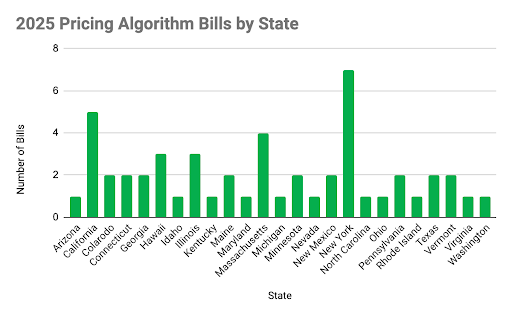Across the U.S., landlords and retailers are increasingly turning to algorithmic pricing tools that adjust prices based on data consumers can’t see and factors they can’t control. In housing, software like RealPage has drawn legal scrutiny for allegedly helping landlords coordinate rent increases through shared pricing analytics. In retail, investigations have uncovered striking disparities: One journalist found that hotel prices in Manhattan jumped by as much as $511 per night when browsing from a Bay Area IP address compared to Phoenix or Kansas City. In Minnesota, a news outlet discovered that Target’s app displayed higher prices on several products, including $148 more for the same vacuum cleaner when reporters were inside the store versus on the far side of the Target parking lot. Uber’s surge pricing model, where fares rise during peak demand, may be familiar, but similar tactics are now spreading. Restaurants are experimenting with peak and off peak pricing, and with the adoption of electronic shelf labels, supermarkets could now raise prices in real time during peak shopping hours.
These examples reflect a troubling trend: prices are becoming fluid, personalized, and opaque. They’re being shaped not just by supply and demand, but by who you are, where you are, what you browse online, and what companies think you’re willing to pay.
Now, states are taking action. In the first seven months of 2025, state legislators introduced 51 bills across 24 states aimed at regulating algorithmic pricing, up from just 10 bills in all of 2024. Most of these measures target rent-setting software accused of enabling price-fixing in housing markets. Others propose limits on surveillance-based pricing tactics that adjust what consumers pay based on personal data, location, or browsing behavior.
About the Project
As part of Duke University’s Science and Technology Policy DukeEngage program, I spent this summer with the Consumer Reports (CR) Technology Policy team exploring how artificial intelligence (AI) is reshaping the consumer marketplace.
To make sense of these changes, we developed a state-level tracker of algorithmic pricing legislation considered in 2025. The tracker highlights key policy trends across three major pricing strategies: algorithmic price fixing, surveillance pricing, and dynamic pricing. Research was conducted using Politico Pro’s Legislative Compass, using the following keyword searches: algorithmic pricing, price setting, price fixing, surveillance pricing, personalized pricing, dynamic pricing, surge pricing, and electronic shelf labels. Each bill was manually reviewed for relevance; a bill was included in the final dataset only if it referenced the use of AI, machine learning, or computational processes in pricing decisions. The tracker’s cut-off date is July 1st 2025, marking the conclusion of the project. Bills focused exclusively on insurance pricing, emergency-related surge pricing for transportation network companies, or dynamic pricing for entertainment tickets within a single transaction window are excluded from its scope.
Check out the short-form tracker here, which organizes each bill by state, sponsor, stage in the legislative process, category, and pricing strategy. For more comprehensive analysis, see the full report with the tracker, along with a table of the bills containing the exact language of their prohibition clauses and key definitions from the bills.
Overview of the Pricing Algorithm Legislation Landscape
State legislative efforts are converging around three primary regulatory targets: algorithmic price fixing, surveillance pricing, and dynamic pricing.

Algorithmic Price Fixing: Algorithmic price fixing refers to the use of software – often trained on nonpublic competitor data or used across multiple sellers in a market – to coordinate prices, effectively reducing market competition. In 2024, seven state bills addressed this practice; by July of the 2025 legislative session, 33 such bills had been introduced. The vast majority (26 out of 33) focus specifically on rent-setting in the housing market. Common provisions ban tools using nonpublic data, restrict shared use among landlords, limit facilitation by service providers, and apply consumer protection or antitrust enforcement.
Surveillance Pricing: Surveillance pricing, sometimes also referred to as personalized pricing, sets customized prices for a consumer or group of consumers based on behavior, biometrics, location, or other personal characteristics. While no bills in 2024 explicitly targeted surveillance pricing, OH SB328 and CA SB1154 laid the groundwork by mandating disclosures when pricing algorithms were used. By July of the 2025 legislative session, there were 13 bills targeting surveillance pricing. Common provisions include prohibitions on using personal data for setting individualized prices, or requirements for clear consumer disclosures when such algorithms are used. Consumer Reports sponsored California’s AB446, a bill that will prohibit surveillance pricing, and supported Colorado’s HB1264, which would have prohibited surveillance prices and wages.
Dynamic Pricing: Dynamic pricing is the real-time or near real-time adjustment of prices based on shifting factors like demand and time, often through algorithms or AI. It includes surge pricing, where prices increase sharply during periods of high demand. We identified three state bills that met our criteria targeting dynamic pricing in 2024, and this number increased to 12 by July 2025. While the bills vary in scope, many target dynamic pricing in specific contexts – such as chain restaurants, transport network companies, WIC-eligible groceries, and special restrictions on electronic shelf labels.
New York currently leads with seven algorithmic pricing bills introduced in 2025, followed by California and Massachusetts, with five and four respectively.

Whether you’re a policymaker, advocate, or curious consumer, we hope this resource helps you better navigate (and shape!) the future of fair and transparent pricing.
If you’re a state legislator interested in working on consumer protection and surveillance pricing—or a state-level organization working with a state legislator—we’d love to chat. Feel free to reach out to grace.gedye@consumer.org.